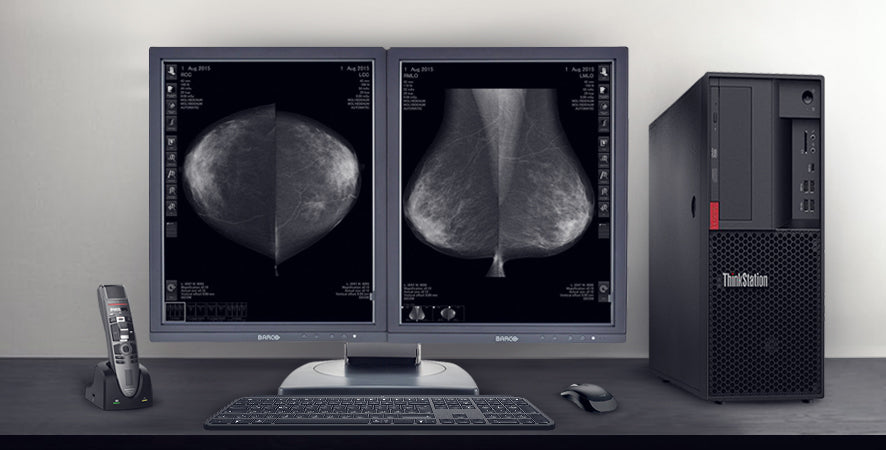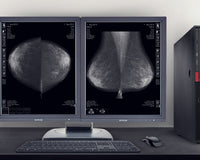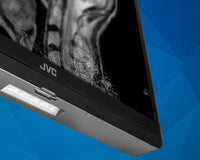As you evaluate all your options for mammography displays in the market, how do you decide what’s best for the needs and budget of your radiology practice or healthcare facility? There are many available makes and models of mammography displays. Choosing one can be a daunting task.
As a buyer of diagnostic display technology, here are seven major considerations you need to take into account when selecting optimal mammography displays:
1. Screen size and resolution
Screen resolution for mammography displays ranges between 5MP and 12MP.
In a dual-head display configuration—that is, two displays set up together as a pair—each monitor has a screen size of 21 inches and a resolution of 5MP. This is the minimum requirement that the MQSA calls for. Learn more about why you need a 5MP display monitor for interpreting mammography cases.
However, a single fusion display—in which breast images that would normally appear on two displays are combined into a single screen so that radiologists can more easily compare the images side by side—has a screen size of about 30 to 33 inches and a resolution of 12MP.
Although fusion displays clearly provide a larger screen and a much higher resolution, one option isn’t “better” than the other. The choice between a dual-head display or a fusion display comes down to personal preference and budget.
Evaluate the pros and cons of each option. Keep in mind:
- Fusion breast imaging displays eliminate the center bezel and provide a more comfortable reading experience due to less movement of radiologists’ eyes and necks.
- Dual-head displays provide redundancy. If one of your monitors fails, you can continue to use the second monitor until a replacement is delivered.
2. Brightness
As brightness of the screen increases, so does the ability to visualize abnormalities that include cancers. A display with increased brightness produces a higher-quality image. Some diagnostic mammography displays have a luminance of up to 2,000 candela/square meter (cd/m2).
Any mammography display you consider buying should:
- Adhere to Mammography Quality Standards Act (MQSA) standards for image presentation throughout the monitor lifespan
- Maintain a continuous level of brightness throughout their lifespan
- Adjust light output to compensate for changes in ambient conditions
- Make levels of brightness consistent across the screen (uniformity)
- Enhance grayscale presentation (DICOM compliant)
This improves image quality and diagnostic accuracy, and can help to reduce eye fatigue for radiologists.
3. Calibration and compliance
With any mammography display monitor you own (or any display monitor, period), the brightness of the screen will dim over time. Ambient conditions may change, impacting levels of brightness. Under the MQSA, mammography display monitors also have to undergo regular quality-assurance tests to ensure that they meet minimum standards for screen resolution, brightness, and contrast.
In these scenarios, you’ll have to calibrate the monitor to compensate for changes, confirm compliance, and maintain high image quality. The question is whether you’ll have to do calibrate the monitor manually, which distracts radiologists’ focus on reading cases, consumes a lot of valuable time, and introduces the possibility for human error, or whether this happens automatically.
You may want to consider buying a mammography display with a built-in front sensor that automatically detects changes in lighting or non-compliance with standards and regulations. Some monitors then make adjustments in real time. The majority of monitors make these corrections when calibration software is run.
The advantages of having a built-in front sensor and automated calibration and compliance include:
- Convenience
- Efficiency
- Fewer disruptions to radiologists’ workflow
- Reduced possibility of errors
- Maintaining compliance at all times
- Greater radiologist confidence in the quality of the images they interpret and the accuracy of their diagnoses
4. Color versus grayscale
Even though grayscale mammography displays have higher brightness and contrast than their color counterparts, color monitors offer advantages that you may want to consider—namely, their versatility and convenience.
Color mammography displays combine—on a single screen—grayscale mammograms with color breast images obtained from other modalities, such as doppler ultrasound and breast MRI. This prevents radiologists from having to drag images into a side monitor to be viewed and interpreted, which is a distraction.
Not only can radiologists read cases in which color is needed for interpretation, but they can also enhance their workflow using color. Prior studies can be shown in a different color text overlay so radiologists can better distinguish cases when comparing current and previous studies. Additionally, CAD markings can be shown in different colors so they’re easier to see.
As multimodality breast imaging continues to increase, the ability to view color images will be especially important.

5. Capability to view 2D or 3D mammograms—or both
Although a 2D mammogram is still the most common type of mammogram, it’s just one picture of each side of the breast. Its main drawback is that it can be difficult to see abnormalities through all the layers of compressed breast tissue, especially in naturally dense tissue.
3D mammograms, or digital breast tomosynthesis (DBT), are rapidly growing in prominence. They capture multiple images of the breast in 1-millimeter-thick slices, which enables radiologists to examine one layer of tissue at a time and from different angles. This can make it easier to detect cancers. 3D mammogram-compliant displays enhance the efficiency of scrolling through several images while ensuring that moving images are in focus.
From a business standpoint and for cultivating a reputation in the marketplace for keeping up with technology advances, it may be important for your practice or facility that your mammography displays can accommodate 3D mammograms.
6. New versus renewed monitors
Certainly, a financial investment in a mammography display monitor is substantial. Did you know that you can save a significant amount of money by buying a renewed product?
Often, renewed monitors served as open-box items at demos or trade shows for industry organizations such as the Radiological Society of North America (RSNA) and the Society for Imaging Informatics (SIIM). Otherwise, they are identical to their brand-new counterparts in terms of cosmetic condition and image quality. Essentially, with a renewed monitor you’re getting a like-new product for much less.
Renewed monitors are also guaranteed to pass all calibration and quality-assurance tests during the standard warranty period of three years. Purchasing a renewed monitor doesn’t mean sacrificing compliance with MQSA guidelines and other industry standards and region-specific regulations.
The decision on whether to buy new or renewed usually comes down to personal preference, budget, and how long you plan to keep the equipment.
7. Warranties
Before purchasing a mammography display monitor, ask about the length of the warranty period and the coverage. Most manufacturers or dealers offer only the most basic warranty coverage. Any extras, such as hot-swap exchanges, carry an additional fee. (A hot-swap exchange is when, in the event of a product failure, a replacement is sent immediately.)
Included with your Monitors.com purchase at no extra charge, our comprehensive standard warranty covers:
- Parts
- Labor
- Hot swaps
- Loaners
- Free remote technical support
- Guarantee to pass all compliance and MQSA requirements
With our hot-swap exchange, we’ll send you a replacement display in advance of the product return and include a prepaid label for you to return the monitor to us. This significantly reduces your downtime and gets you up and running by the next day, if you request overnight delivery.
The standard warranty period for renewed monitors is three years. For new monitors, it’s five years. For customers who prefer full five-year coverage on their renewed monitors, we offer extended warranty options on all renewed products.
Additionally, we offer a 30-day, money-back, 100%-satisfaction guarantee—with no restocking fee.
We’re the only company in our industry that offers this level of complete coverage.






